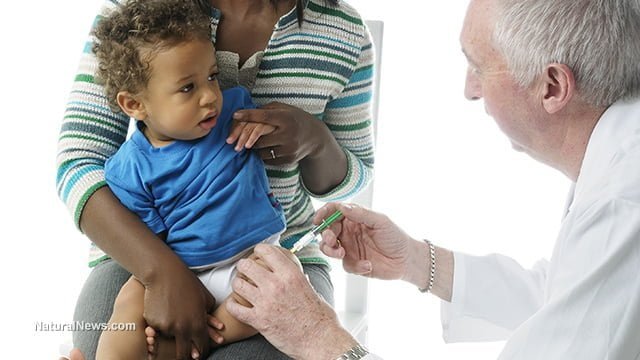
Wealthy countries that require the highest number of vaccines for children under the age of 1 also have the highest rates of death in that age group, according to a study conducted by an independent computer scientist and a researcher from the Think Twice Global Vaccine Institute, and published in the journal Human & Experimental Toxicology in 2011.
The study stemmed from the recognition that while the U.S. vaccine schedule calls for more vaccine doses than any other country, the United States still ranks 34th among nations in terms of infant mortality.
For the purposes of the study, the researchers defined a “vaccine dose” as “an exact amount of medicine or drug to be administered.” Thus, triple vaccines such as DTaP or MMR are each considered to be three vaccine doses, since three drugs are being given at the same time.
The U.S. vaccine schedule calls for 26 vaccine doses before age 1.
More vaccination, more infant death
The researchers collected infant mortality rates (IMRs) for the top 34 countries in the world. Four of the countries – Andorra, Liechtenstein, Monaco and San Marino – had so few infant deaths (fewer than five) that their IMRs were considered statistically unreliable, so these countries were excluded from the analysis.
For the remaining 30 countries, a higher number of required vaccine doses was associated with a higher IMR – refuting the argument that a higher number of vaccinations improves overall infant health.
In fact, most of the vaccines recommended for children under age 1 are not intended to prevent diseases that are dangerous in that age group. Instead, U.S. vaccine policy emphasizes vaccinating children at as young an age as possible, including against diseases that are only dangerous later in life.
The countries were then divided into five different groups, depending on how many vaccine doses they require for children under age 1: 12–14 doses, 15–17 doses, 18–20 doses, 21–23 doses and 24–26 doses. The researchers found that countries in the 12–14 dose group had significantly better (lower) IMRs than countries in the 21–23 or 24–26 groups.
What is causing these deaths?
The researchers noted that many factors contribute to IMR, which is considered one of a country’s most important public health indicators. Poor countries tend to have high IMRs because of the absence or poor distribution of basic health services and infrastructure, including sanitation. Infectious diseases tend to be more common in these countries, largely because of that same poor health infrastructure and poor nutrition.
In wealthier countries, however – such as those examined in the current study – the factors contributing to IMRs may be less clear. For example, the United States saw an increase in premature births between 1990 and 2006, but this increase is not sufficient to explain the country’s unusually high IMR for a wealthy nation.
“It appears that at a certain stage in nations’ movement up the socio-economic scale—after the basic necessities for infant survival (proper nutrition, sanitation, clean water, and access to health care) have been met—a counter-intuitive relationship occurs between the number of vaccines given to infants and infant mortality rates: nations with higher (worse) infant mortality rates give their infants, on average, more vaccine doses,” the researchers wrote.
“This … elicits an important inquiry: are some infant deaths associated with over-vaccination?”
The researchers note that even in poorer countries, high levels of vaccination do not seem associated with a good IMR. For example, Gambia requires 22 vaccine doses before age 1, and has a vaccine compliance rate of 91–97 percent, but still has an IMR of 68.8. Mongolia also requires 22 doses, with a compliance rate of 95–98 percent, but still has an IMR of 39.9.
“These examples appear to confirm that IMRs will remain high in nations that cannot provide clean water, proper nutrition, improved sanitation, and better access to health care,” the researchers noted.
Disclaimer: We at Prepare for Change (PFC) bring you information that is not offered by the mainstream news, and therefore may seem controversial. The opinions, views, statements, and/or information we present are not necessarily promoted, endorsed, espoused, or agreed to by Prepare for Change, its leadership Council, members, those who work with PFC, or those who read its content. However, they are hopefully provocative. Please use discernment! Use logical thinking, your own intuition and your own connection with Source, Spirit and Natural Laws to help you determine what is true and what is not. By sharing information and seeding dialogue, it is our goal to raise consciousness and awareness of higher truths to free us from enslavement of the matrix in this material realm.
Português
 EN
EN FR
FR


























Can’t speak for others only myself. I don’t vaccinate since after getting the flu vaccine I experience anaphylactic shock and am hospitalized. Interestingly when I worked at a charity shop I worked with a lady who also was given the flu shot by her doctor then ended up in hospital as she also couldn’t breathe.
When I was in hospital long ago (I no longer touch vaccines) it was interesting that the registered nurse when told I had an adverse reaction to the flu vaccine blurted out “not another one!”. I have since looked at the ingredients of vaccines-ethyl mercury; aluminium hydroxide; anti freeze; fluoride; etc etc these can’t be any good for you being injected into our blood streams can they?
Interesting huh!
This article doesn’t surprise me at all. It’s nothing new.